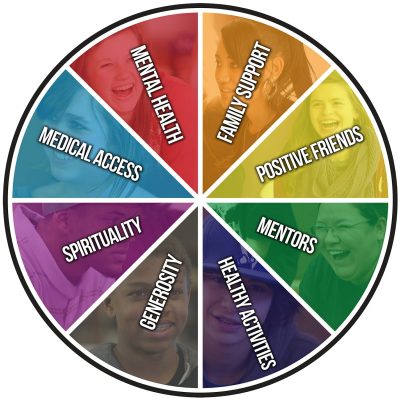 Breaking the code: How seeking help can save lives
Breaking the code: How seeking help can save lives
By Andrea Poncia
Health promotion campaigns often highlight the negative impacts of a harmful behaviour, and then provide information about healthier alternatives. It’s an approach that assumes the audience is capable of changing habits and behaviours, and it works best for things that are fairly easy to change, like wearing seat belts.
Unfortunately, this approach can sometimes have the opposite effect. For example, youth who feel suicidal are less likely to seek help, and experience greater distress after being exposed to this type of campaign. To support suicide prevention planning, the Province of Manitoba developed guidelines that outline the harms of focusing on shock and trauma, and discuss how to constructively address suicide among youth. A similar theme of caution about fear- based messaging comes from the Canadian Association of Suicide Prevention’s guidelines about how to report on suicide in the media.
While there is little evidence that negative messaging promotes behaviour change in relation to suicide, there is consensus that suicide prevention efforts should focus on identifying people who are at-risk, and promoting help-seeking. For example, in 2015, 13% of high school students surveyed in Ottawa seriously considered suicide, and of these, 71% didn’t know where to turn. To address this, a cross-sectoral group of organizations set-out to identify programs that could be implemented to reach and engage vulnerable youth. These organizations came together through the Community Suicide Prevention Network (CSPN) that led a process to identify an evidence-informed practice to promote help-seeking.
 The CSPN consulted the Suicide Prevention Resource Center (SPRC) and SAMHSA’s National Registry of Evidence-based Programs and Practices (NREPP). Both websites listed a program called Sources of Strength as a promising practice, and, in 2014, Ottawa joined cities throughout the United States and Australia in implementing the program. It is currently being offered in 23 local high schools. While more research is required to better understand Sources of Strength, there is promising evidence that it can be a powerful tool to increase help-seeking behaviours.
The CSPN consulted the Suicide Prevention Resource Center (SPRC) and SAMHSA’s National Registry of Evidence-based Programs and Practices (NREPP). Both websites listed a program called Sources of Strength as a promising practice, and, in 2014, Ottawa joined cities throughout the United States and Australia in implementing the program. It is currently being offered in 23 local high schools. While more research is required to better understand Sources of Strength, there is promising evidence that it can be a powerful tool to increase help-seeking behaviours.
One of the ways to promote help-seeking is by focusing on relationships. Youth who have suicidal thoughts tend to gravitate to people who have had similar life experiences, so they often engage with peers who have also experienced suicidal thoughts and actions. This can lead to a situation where suicide is seen as a common-place response to crisis. The Sources of Strength program aims to counteract this normalization of suicide by bringing adult and youth leaders together to plan outreach activities in schools with the aims of changing norms about seeking help, promoting resiliency, building relationships between youth and adults, and shifting the perception that suicide is a normal response to crisis.
 The program is based on the notion that youth become less vulnerable to suicide when they are integrated within deep and high quality relationships that promote positive norms, such as help-seeking. This is important for a few reasons: one is that relationships play a vital role in helping us navigate choices. Young people’s decisions are highly influenced by the norms within their social groups. Another is that relationships with positive people foster a sense of well-being, and create opportunities for loved ones to notice vulnerability and make connections to services when needed.
The program is based on the notion that youth become less vulnerable to suicide when they are integrated within deep and high quality relationships that promote positive norms, such as help-seeking. This is important for a few reasons: one is that relationships play a vital role in helping us navigate choices. Young people’s decisions are highly influenced by the norms within their social groups. Another is that relationships with positive people foster a sense of well-being, and create opportunities for loved ones to notice vulnerability and make connections to services when needed.
To understand the effectiveness of the program, Wyman et. al., evaluated how Sources of Strength impacted the breadth and quality of youth relationships with trusted adults. They also looked at how willing peer leaders would be to get adult help when their peers requested secrecy about their suicidal feelings.
For this study, the Sources of Strength peer leaders worked with adult advisors to develop messaging campaigns. These carefully crafted campaigns consisted of class presentations where youth leaders talked about their strengths, and named trusted adults. Adult advisors were present during these sessions to ensure all of these components were included in the youth’s messaging. As health promotion activities are enhanced when there are opportunities for audience participation, peer leaders engaged student participants to do the same.
What they found was promising. Sources of Strength peer leaders were more likely to believe that adults were available to help them in the school. They were more likely to connect their peers with suicidal thoughts to adults, they expressed fewer negative coping mechanisms, and were more engaged within their schools.
What’s more, youth who were suicidal experienced the biggest benefit. As for the youth who were already resilient when they came into their peer leader roles, they were more likely to refer peers to adults than before the program.
 Petrova et. al showed that after three months, Sources of Strength led to changes within the whole school population. The greatest shift was in students’ perceptions that there were adults in the school that they could turn to for support. Overall, there was greater acceptance that asking for help was a good thing. Once again, the students who had the most positive changes were those who had suicidal feelings or thoughts.
Petrova et. al showed that after three months, Sources of Strength led to changes within the whole school population. The greatest shift was in students’ perceptions that there were adults in the school that they could turn to for support. Overall, there was greater acceptance that asking for help was a good thing. Once again, the students who had the most positive changes were those who had suicidal feelings or thoughts.
These results are encouraging considering that currently, most youth only disclose their suicidal thoughts to peers. While more research is needed to build on the studies that only looked at the short term, Sources of Strength offers a promising practice for suicidal youth, known to have fewer deep ties to supportive adults, to learn that it’s ok to ask for help, and to be exposed to opportunities to build resilience. It is likely not the only program that can bring about positive change, but it certainly reinforces the notion that providing positive and effective supports can make a difference.
Bibliography
Ottawa Public Health. Ottawa Student Drug Use and Health Report, 2014. Ottawa (ON): Ottawa Public Health; 2014.
Bennett, K., Cheung, A., Manassis, K., Links, P., Mushquash,C., Braunberger, P., Newton, A. S., Kutcher, S., Bridge, J., Santos, R.G., Manion, I., McLennan, J., Bagnell, A., Lipman, E., Rice, M., Szatmari, P. (2015). A Youth Suicide Prevention Plan for Canada: A Systematic Review of Reviews. Canadian Journal of Psychiatry, 60 (6), 245-257.
Petrova, M., Wyman, P. A., Schmeelk-Cone, K., Pisani, R. A. (2015). Postive-Themed Suicide Prevention Messages Delivered by Adolescent Peer Leaders: Proximal Impact on Classmate’s Coping Attitudes and Perceptions of Adult Support. Suicide and Life Threatening Behaviour, 45 (6),
Pisani, R. A., Schmeelk-Cone, K., Gunzler, D., Petrova, M., Goldston, D. B., Tu, X., Wyman, P. A. (2012). Associations Between Suicidal High School Students’ Help- Seeking and their Attitudes and Perceptions of Social Environment. Journal Youth Adolescence, 41, 1312-1324.
Schmeelk-Cone, K., Pisani, R. A., Petrova, M., Wyman, P. A. (2012). Three Scales Assessing High School Students’ Attitudes and Perceived Norms About Seeking Adult Help for Distress and Suicide Concerns. Suicide and Life Threatening Behaviour, 42 (2), 157-172.
Wyman, P. A, Brown, H., LoMurray, M., Schmeelk-Cone, K., Petrova, M., Yu, Q., Walsh, E., Tu, X., Wang, W., (2010). An Outcome Evaluation of the Sources of Strength Suicide Prevention Program Delivered by Adolescent Peer Leaders in High Schools. American Journal of Public Health, 100 (9), 1653-1661.